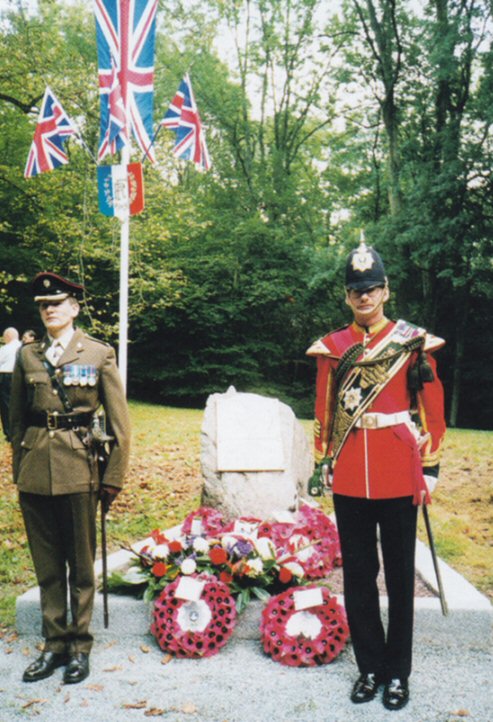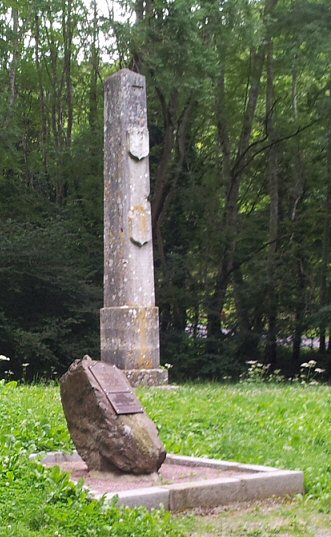After 56 years Bronze Plaque Memorial unveiling
On Sunday 27 August 2000, a party of 44, including survivors of the battle, gathered at site which was the 1st Battalion Headquarters during the fighting on the route to Tilly in August 1944. The service was conducted by the Rev Prebendary 'Benny' Goodman, who was a Worcestershire liaison officer with 214 Brigade during the fighting. The memorial stone was quarried from the Malvern hills and with bronze plaques in French and English, was unveiled by Peter Carter, Chairman of Worcestershire County Councill, Vice President of Kidderminster Branch WFRA and a great supporter of the Regiment. He spoke of his pride in the contribution made by soldiers of the Worcestershire Regiment to the restoration of freedom. He told the Mayors of Vernon and Tilley and the Regional Senator that it will never be possible to quantify the value of the sacrifices made, "but there can be no doubt that it is in moments of time such as the battle we are remembering today that the course of history was changed both for your country and for mine."

The Rev. Prebendary D. C. "Benny" Goodman dedicates the Memorial after it was unveilled by Councillor Peter Carter
(photo provided by Brian Hildersley) |
After the unveiling homage was paid to the fallen, during which Drum Major Kevin Hellings of 1st Battalion Worcestershire & Sherwood Forester Regiment (WFR) sounded 'Last Post' and Association Standards were dipped. Standards were carried by veterans Jack Bullock and David Plant, both of Malvern, and the Standard of 43 Wessex Division Association was carried by its Secretary, Bill Edwardes (who was a stretcher-bearer with the Worcestershire Regiment in 1944), also a Worcestershire veteran and organiser of the memorial project. Major Mark Holden, second-in-command. represented the 1st Battalion. Whilst in Vernon the Regimental party joined the Mayor and citizens to honour members of the Resistance and citizens of Vernon who had died during the occupation. Many kind words and votes of thanks to the Worcestershire Regiment were received, and the hospitality of our French hosts was kind and generous. The two days of ceremonies ended with a cruise and lunch on board a Seine river boat. The "Worcesters' Lay-by" project was conceived by a small group of veterans who wanted to mark the place where so many of their comrades fought and died. The rough-hewn stone. weighing one ton, was donated by the quarry through the good offices of veteran Jack Bullock from Malvern. Transportation was carried out by David Plant, another Malvern veteran, and the plaques were made by the blacksmith's shop at Leigh Sinton.
|
Major Mark Holden and Drum Major Kevin Hellings who sounded the Last Post |
Memorial next to Monument (photo provided by Brian Hildersley) |
The memorial is next to the Monument on the route towards Tilly. This was the location of Headquaters Company of the 1st Battalion Worcestershire Regiment during the fighting in August 1944. Today there are still signs of bullet damage to the monument Any one wishing to find this memorial should follow the signs from Vernon towards SNECMA. |

Bill Edwardes, Ron Cherry and Councillor Peter Carter
(photo provided by Brian Hildersley) |
Monument at the lay-by location (August 1944) |
(photo provided by Brian Hildersley)
|
Lieut. "Benny" Goodman (1944) |
Private Bill Edwardes |
|
Private Ron Cherry (1944) |
|
Ron was with 7 Platoon of 'A' Company and sightly wounded during the fighting in August 1944. He was captured by the Germans and ended up as as POW at Stalag 7A. |










